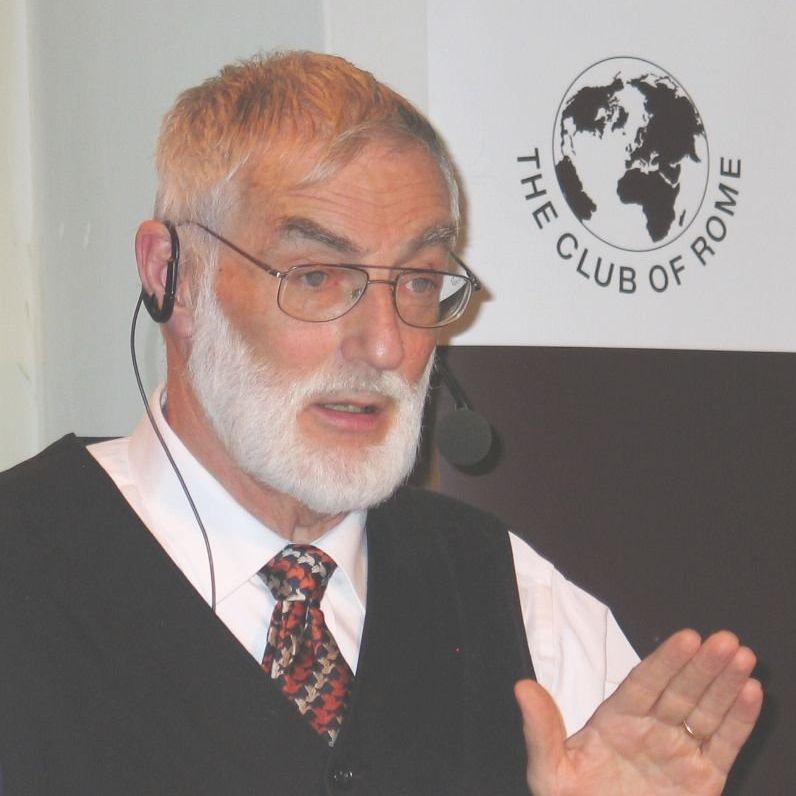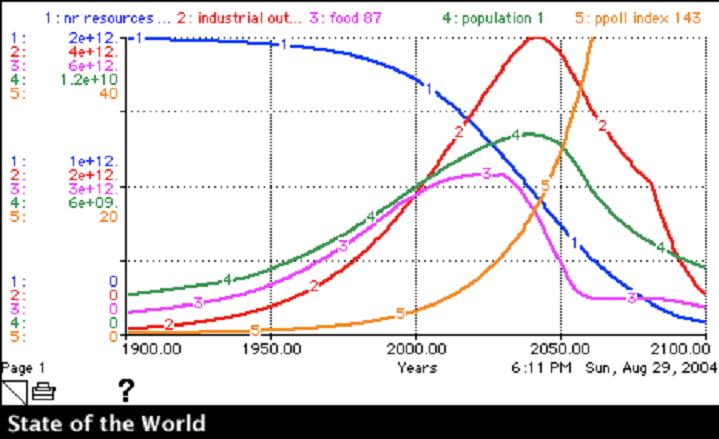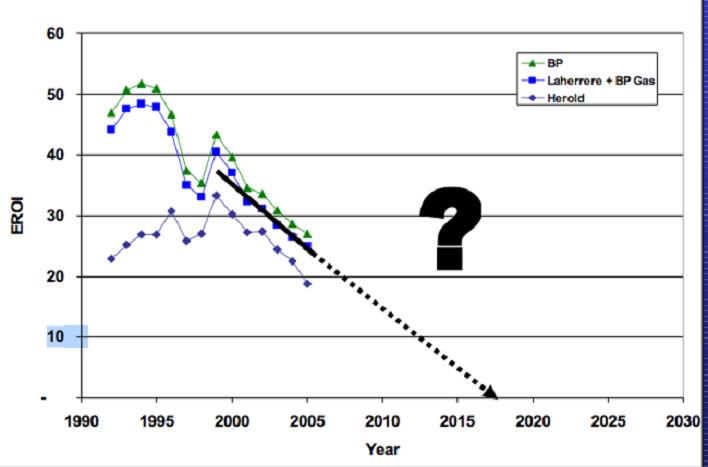Dennis Meadows

File: c:/ddc/Angel/BestIntentions/Meadows.html Date: Fri Jul 09 20:50:44 2010 (C) OntoOO/ Dennis de Champeaux

We need to step back. Meadows's team extended a world simulation
system that was originally written by J.W. Forrester around 1970/2.
The World3 program predicted that a population collapse could
start after around 2050. Tweaking the model to force a better outcome
required:
- assuming extensive recycling of natural resources
- assuming substantial improved ways to deal with pollution
- assuming a doubling of agricultural productivity
- assuming 'perfect' family planning (no details)
Even with these assumptions, the model predicts the population to collapse before 2100. The insidious effects of exponential growths is beyond humanity's control ability - according to the model.
The standard response was that the model must be flawed because human ingenuity would overcome the challenges.
The 1992 text "Beyond the Limits" made a way stronger statement. Humanity had entered a non-sustainable phase. Human ingenuity had not kept up. As a result, humanity's 'ecological footprint' had surpassed the planet's carrying capacity around 1980. Ecological footprint is defined as the amount of land required to produce the basic resources of grain, feed, wood, fish, and urban land.
The 2004 text LTG30, elaborated the situation. One point two (1.2) earths were required in 2000 to sustain humanity's lifestyle - i.e. resource consumption and absorption of emissions - as quoted from [Wackernagel].
The World3 model is an aggregate of the whole planet and as such does not make distinctions within societies, between different nations and between different regions. The initial research to assemble the raw data to feed the model revealed, of course, substantial differences in wealth and consumption levels.
Although not relevant for their total model they remark about the cause of the poor-rich difference within societies:
... social arrangements ... that systemically reward the privileged with the power and resources to acquire even more privileges. ... tax loopholes for the wealthy ...This resembles Diamond's nefarious perspective of the rich. Public education having fished out during a century IQ from the bottom 50% and which over-procreates is a more plausible explanation for the increase of the poor-rich gap (and makes it way harder to reduce it).
They remark also, quite relevant for their model, that the distinction between poor and rich regions is missing in their model:
... it's easier for rich populations to save, invest and multiply their capital than it is for poor ones to do so. ... In poor countries ... capital growth has a hard time keeping up with population growth ... (is) required to provide schools and hospitals and to fulfill subsistence consumption needs.The tendency of the aggregate model to generate collapses while only very specific interventions (see below) yield a steady state suggests that the model may be wildly optimistic. Global wealth differences are fertile sources of conflicts and disruptions, which may be their own genesis of a collapse.
The World3 model tracks key parameters from the year 1900 to 2100. It is based on ferreted out historical data regarding these key parameters and on postulated causal connections between them. Here their reference scenario that 'predicts' what happens in the 21st century when no interventions are done:

The model is invalid after it finds a collapse, because no one can predict how humanity will respond in such an event. The collapse in the reference scenario occurs around 2040 when the population starts a rapid decline (graph label 4). The population decline is likely due to the rapid decline of the earlier food production (graph label 3) and the rapid build-up of pollution (graph label 5), caused by the growth of industrial output (graph label 2). The actual mechanism is more complex than sketched above due to the intricate causal connections in the model. The sophistication of the model is its strength but in a sense also its weakness since there is no easy access to the inside of the model for outsiders.
The validity of the model's reference scenario is impossible to assess without technical know how and even then one must be very cautious. The authors of the model do not claim that the values of the graphs on time points are accurate. The graphs can shift somewhat to the left or the right. Instead they claim only (sic) that they believe in the qualitative behavior of the model. Tinkering with assumptions in the model (corresponding with more optimism) does not change the qualitative behavior of the model. This sensitivity argument is fine for technical minds but will not sway those that believe that dooms-day scenarios are rubbish.
The detailed model inspired the authors to play what-if games as they
did already in 1972. They created another series in 2002, which they
describe in detail. The following model adjustments, corresponding
with drastic interventions starting in 2002, produce a sustainable
world:
- All people (worldwide) agree to a 2-child maximum
- Industrial output per capita is capped to achieve a moderate, but
not excessive lifestyle for all
- Investment in technologies are made to increase the efficiency of
resource use, to decrease pollution, to control land erosion, and to
increase agricultural land yields
The population levels off with these adjustments to less than 8B
people.
Running the model with the same adjustments starting in 1982 produced a way better stable world with about 6B people. Here their comment:
This society has a more pleasant environment, more resources, more degrees of freedom; it is farther from its limits, less on the edge than the society in Scenario 9 [starting in 2002]. That future might have been possible once. But the world society of 1982 did not grasp the opportunity.
Running the model with the same tough interventions starting in 2022:
... policies that were once adequate are no longer sufficient ...produce a collapse.
As mentioned above, dismissing the World3 model has been the standard
response by pointing to human's ability to deal in unpredictable
way with adversities and its engineering feats in the preceding
centuries. This ignores 20th century genocides, 150+M war conflicts
deaths, economic income stagnation in the US since around 1973 for the
bottom 50%,
majorities in welfare states who depend on social services from their
governments, etc. Meadows details the evolution of rejections to
their model as follows [Meadows2009]:
-- 1970s: There are no limits.
-- 1980s: There are limits, but they are distant in time.
-- 1990s: The limits are near, but they are irrelevant since the
market will deal with them.
-- 2000s: The market is not adequate, but new technologies will let us
evade the limits without requiring that we stop growth.
Can technology deal with the 'detail' of physical reality? Here a graph from [Meadows2009] regarding the return on investment on the production of energy:

We have had discussions for decades about decreasing dependency on oil from questionable countries, while the import from these unpleasant regions only increased steadily. This discourse has masked the more important topic that cheap energy - on which the world economy depends - is slowly but surely disappearing. 'Alternative energy' is a wonderful expression and the term 'clean coal' is a brilliant marketing invention, but their ability to replace cheap oil energy is clouded in dense fog, if it is not an illusion.
Sure, cracking the crust with fracking allows access to formerly hidden energy resources, which has actually lowered energy prices (in the US). However, we continue relying on fossil fuel and contributing to climate change and making life more difficult for solar and wind companies.
Hence, if nothing else, we endorse their:
It would be safer, and probably preferably for other reasons as well, to learn to live satisfying lives safely below the globe's estimated limit, rather than always straining to achieve the maximum that is physically possible.It goes under the name of 'prudence', or as Warren Buffett once said: "Don't play too close to the line."
That is exactly what our governments are not doing. Economic growth, for good or for bad, is mandatory to maintain the taxable flux. A slightest economic dip is causing hand wringing and deficit financing to provide essential services to their dependent majorities.
The last chapter, apparently written by Donella Meadows, the optimist, recommends the tools of visioning, networking, truth-telling, learning and loving to channel humanity into a sustainable future. We omit the details, because we believe that our options are shrinking rapidly. Draconic interventions may become or are already necessary.
The recommendations by the team made in three books during 1972-2004 have not been picked up. Humanity is not accustomed with a prediction that things may go seriously out of hand 70-40 years in the future. Not seeing clear evidence by the public at large and even by our leaders 'justifies' inaction. Metaphors like: "eating our seedlings", "living on capital instead of income", "squandering the inheritance of future generations", "preserving the world for our children" does not resonate with a population segment that is struggling as usual to get by, while the more affluent segment has experienced so much material progress that they believe that the 'experts on tap' will do the magic to take care of whatever is far ahead. The Meadows's team worked hard on explaining already existing 'overshoot' and that the 'system's signals' are ignored. Our leaders, at all levels, have their hands full dealing with slowly increasing chaos. Hence they push larger topics that are not yet critical forward, not realizing that choices are shrinking and may even vanish.
Dennis Meadows described himself in LTG30 (2004) as in between optimism and pessimism. He appears to have given up hope that a collapse can be avoided in the 21st century; personal communication 2010.
A little dialog we found:
-- Even if he is right that a collapse cannot be avoided, inaction is
not warranted.
-- I agree that we cannot as a society fail to respond, even if
mitigation is the best we can hope for.
[Meadows2009] Meadows, D., Economics and Limits to Growth: What's Sustainable?, slides of lecture given at The Population Institute Washington, DC, 2009 October.
[Wackernagel] Wackernagel, M. et al, "Tracking the ecological overshoot of the human economy", Proceedings of the Academy of Science, 99, no. 14, pp 9266-9271, Washington DC, 2002.